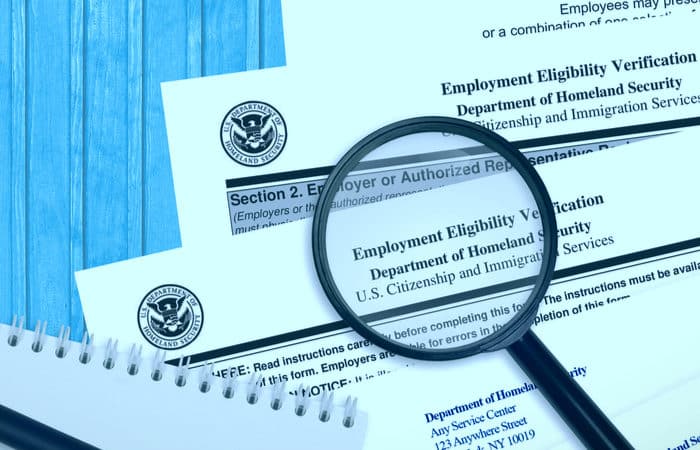I-9 Retention & Purges – A Guide to Why They’re Important
As we’ve mentioned before, Form I-9, or Employment Eligibility Verification, is a crucial part of corporate compliance. While some organizations may choose to deliberately break the law in this regard, the unfortunate reality is that completing Form I-9 is a complex undertaking, and often violations occur unintentionally.
With over 1,200 rules and regulations and 15 pages of instructions, filling out the form can be overwhelming – but with the right tools, achievable! Now it’s time to look at the rules, regulations and best practices around I-9 retention and purging.
I-9 retention: What are the rules?
What should be kept?
There are a few options for how to retain your Form I-9s. They can be stored on paper, microfilm or microfiche, or electronically. You can also have them in single or a combination of formats – that is, some electronically and perhaps older versions in paper format. They can be stored onsite or offsite at a storage facility, but you must be able to produce them for inspection within three business days of a request by government officials.
In terms of these officials, you would most likely be asked by officers of the Department of Homeland Security, employees from the Immigrant and Employee Rights Section (IER) at the Department of Justice, and/or employees from the Department of Labor. The instructions and any pages that you or your employees have not written on don’t need to be kept – retain all pages that information has been written on. Insufficient or incomplete forms are a violation of section 274A (a)(1)(B) of the INA (8 CFR Part 274a .2(f)(2)).
In I-9 retention, electronic storage requires having some controls in place. This includes controls to ensure the integrity and reliability of the system, controls to prevent unauthorized creation, alteration of deletion of Form I-9s (and corresponding electronic signature requirements), a quality assurance program that regularly evaluates the system, and controls to ensure audit trails in case any changes to the form are made.
What is the I-9 retention period?
Once you have correctly and thoroughly filled out the Form I-9, you must keep it on file for every employee you hired in the U.S. after November 6th, 1986. For those employed in the CNMI, this date changes to on or before November 27th, 2009.
As long as an employee currently works for you, you must have the I-9 on file. This applies even if the employment ended shortly after hiring. So how long must you retain the Form I-9 after an employee stops working for your organization?
According to federal regulations, you must retain the Form I-9 for three years after the date of hire, or one year after the date of employment ends – whichever is later.
According to USCIS, the way to calculate how long to keep a former employee’s Form I-9 (the I-9 retention calculator or formula) is:
- If they worked for less than two years, you must retain their form for three years after the date you entered in the ‘First Day of Employment’ field.
- If they worked for more than two years, retain the form for one year after the date they stopped working for you.
- After these respective periods, it’s important that employers purge an employee’s I-9, according to the form’s retention requirements.
How to effectively retain I-9 forms and files
Keep separate from personnel records
Always maintain the Forms I-9 separate from any employee personnel records. Usually, they are kept in a file or binder that’s only available for certain individuals in the HR department to access. The reason that managers (or supervisors) shouldn’t have regular access to these files is because they – or other related documentation – may contain protected information, such as immigration status or national origin.
Define the three sections
- Administration
- Active employees
- Terminated employees
Most Form 1-9 files or binders have these three sections separated for convenience.
Administration section
Your first section should contain administrative information, including relevant policies and documentation. Some of the types of documents you may want to file in this section include:
- A copy of the Handbook for Employers and Form I-9 instructions
- Any necessary documents or spreadsheets to track reverifications and temporary visas that will expire in the future
- Security guidelines if you are storing your I-9 records electronically
- Documentation of the results of all internal Form I-9 audits you have conducted. This is important to keep on file as it shows that you have taken action to correct any past mistakes related to the Form I-9, or in the case of I-9 documents getting lost or destroyed. If necessary, this is where you can store any information on why Forms I-9 were completed later than they should have been. In the case of a formal Form I-9 audit, this can impact the financial penalties and fines your organization is subjected to.
Active employees section
Your second section should include active employee I-9 forms, and these should be filed alphabetically. Storing them alphabetically by last name makes it easy to audit against your current payroll information.
Terminated employees section
The third and final section should be for terminated employees’ Form I-9.
When an employee is terminated, you should calculate two I-9 retention dates. As explained above, you should have the date of post-hire, i.e. the three-years-after-hire date, and the date of post-termination, i.e. the one-year-after-termination date. Once you have these two dates outlined, you can cross off the earlier date. The one remaining, the later date, is the I-9 retention date for this employee.
Once the date has been determined, terminated employees should be organized chronologically by retention date.
Purging terminated I-9s when past the retention period
Storing your terminated employees’ Forms I-9 by retention date makes it easy to check terminated I-9s to see if any of the retention dates have passed. If they have, you can easily pull those I-9s and purge them.
An easier way to track and organize I-9 retention
From paper form digitization to ongoing electronic I-9 management, Tracker I-9 Compliance is the industry’s most advanced I-9 compliance offering. Take advantage of the only end-to-end I-9 compliance software solution that’s maintained a perfect 20+ year track record of zero client fines.
[bctt tweet=”Completing Form I-9 is a complex undertaking, and often violations occur unintentionally.” via=”yes”]




